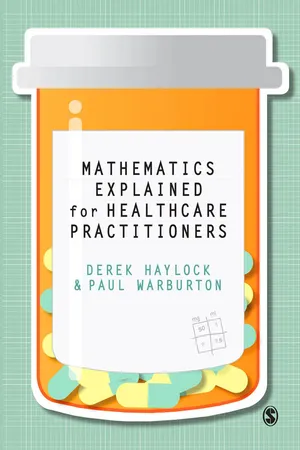
Mathematics Explained for Healthcare Practitioners
Derek Haylock,Paul Warburton
- 264 pages
- English
- ePUB (mobile friendly)
- Available on iOS & Android
Mathematics Explained for Healthcare Practitioners
Derek Haylock,Paul Warburton
About This Book
If you find mathematics a struggle, or if mathematics makes you panic - whether you?re a student preparing for a calculations test, or a qualified healthcare professional - this is the book for you.
Its focus is first and foremost on helping you develop a proper and lasting understanding of mathematical concepts and processes in a healthcare context, with an emphasis on developing mental strategies to reinforce your feeling for number and numerical relationships. Clear, accessible chapters take you step-by-step through specific sets of objectives, and once you feel you have fully mastered a particular mathematical process, you?re encouraged to practise your skills through a range of practical examples. Each chapter also contains a ?Spot the Errors? feature designed to reflect the busy, pressurised healthcare environment.
Written by Derek Haylock, a best-selling mathematics educator, and Paul Warburton, co-ordinator of the Non-Medical Prescribing programme at Edge Hill University, the book is directly linked to the NMC?s competencies and will give you the confidence to perform the safe, error-free calculations required of all healthcare professionals.
Frequently asked questions
Information
| UNDERSTANDING THE NUMBER SYSTEM | 1 |
- understand the place-value principle in our number system for both whole numbers and decimal numbers
- use and interpret powers of 10
- recognize the positions of whole numbers or decimal numbers on a section of a number line
- appreciate where zeros are needed in decimal numbers
- express a decimal number as tenths, hundredths or thousandths
| 1 | The digit 7 in the number 87 654 represents seven thousand. |
| 2 | Counting in ones, the next number after three thousand and ninety-nine is four thousand. |
| 3 | On a number line 8050 lies halfway between 8000 and 8100. |
| 4 | To calculate the cost per day of a 28-day course of medicine costing £75.60, a pharmacist enters 75.60 ÷ 28 on a calculator and gets the result 2.7; this means the cost per day is two pounds and seven pence. |
| 5 | The number 0.0008 is ‘eight ten-thousandths’. |
| 6 | The number halfway between 0.007 and 0.008 is 0.075. |
| 7 | The number 4567 is equal to (4 × 103) + (5 × 102) + (6 × 101) + (7 × 100). |
| 8 | The number 0.067 is equal to (6 × 10–2) + (7 × 10–3). |
| 9 | In this set {0.09, 0.8, 0.084, 0.18, 0.48}, the greatest number is 0.8 and the smallest number is 0.084. |
| 10 | 1.275 is equal to 1 unit and 275 thousandths, which is 1275 thousandths. |
How does place value work?

| Figure 1.1 | A table showing increasing powers of 10 |
Statement 2
Statement 4
Table of contents
- Cover Page
- Title Page
- Copyright
- Contents
- About the Authors
- Acknowledgements
- Introduction
- A Disclaimer
- 1 Understanding the Number System
- 2 Addition and Subtraction Skills
- 3 Multiplication and Division Skills
- 4 Units of Length
- 5 Units of Liquid Volume
- 6 Units of Weight
- 7 Using a Calculator
- 8 Rounding
- 9 Calculations with Decimal Numbers
- 10 Imperial Units Still in Use
- 11 Understanding Fractions and Ratios
- 12 Proportionality and ‘Per’
- 13 Percentages
- 14 Miscellaneous Mathematics
- 15 Application
- Answers to Check-ups
- Index